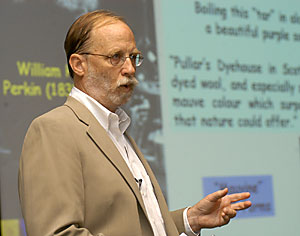 |
|
KEVIN B. KLAUS / Arizona Daily Wildcat
|
Optical sciences and chemistry professor Neal Armstrong presents "Nanoscience Ushers in the Beginning of 'Plastic Electronics'" yesterday afternoon at the Gallagher Theater in the student union. Armstrong's talk explained how organic light emitting diodes will be able to be printed off a normal inkjet printer.
|
|
|
By Joe Ferguson
Arizona Daily Wildcat
Thursday, October 28, 2004
Print this
In the future, chemistry professor Neal Armstrong says a common dye could be used to drastically reduced the price of computer technology.
Armstrong, the feature speaker at yesterday's Faculty Fellows, said his research into technology in Organic Light Emitting Diodes could bring cheap, flexible displays to consumers in the next ten years.
The eventual goal is to produce an electronic paper which would allow consumers to move away from paper. This electronic paper could be infinitely refreshed, letting the reader choose different articles to read on a whim, Armstrong said.
OLEDs are already available to the consumers, although are mostly confined to cell phones and car stereo displays.
Armstrong said the next generation of OLEDs that he and his team are researching will employ a dye commonly found in paints called phthalocyanine. Current OLEDs use expensive metals or special electrically conducive polymers that must be grafted on top of the transistors and circuits. In addition, either material is graphed onto a plastic substrate through a complex vacuum process.
Armstrong told the mix of faculty and students that using the dye in conjunction with special printers similar to technology found in ink jet printers would far less expensive. The dye, which is far cheaper than either polymers or the metals currently being used, would be printed onto the circuits and transistors. "Someone has to demonstrate that we can take ink to an electronic device," Armstrong said.
Armstrong concedes the OLED technology is not perfect, and that currently scientists cannot produce true red colors. Both the colors green and blue can be reproduced in current OLED technology.
Answering a question from the audience, Armstrong said Proposition 102 was a good idea. Proposition 102 would allow universities to accept stock in private companies from professors who want to license their inventions.
Armstrong mentioned two companies, both involved in plastic electronics, as examples of how trading stock for licenses can get a product to market quickly. Plastic Logic and Cambridge Display both gave Cambridge University 50 percent equity in their companies to pay for their licensing fees.
"They got off the ground real quick," Armstrong said.
Armstrong was also asked whether the domestic manufacturing of the OLEDs could be lost to overseas competition. He said that it was true that most LCD production is done overseas, companies like Kodak, Xerox, 3M, Motorola and Intel are actively following breakthrough. But no one is planning production at this time.
"It took 15 years to get LCDs to the consumer market, and it could be another 10 years before OLEDs are widely available on the consumer market." Armstrong said.
Wei Xia, a chemistry doctoral student, said innovations in OLEDs will lead to cheaper electronic componets.
Xia said has been working with Armstrong for four years, using X-ray crystal diffraction to look at the atomic structure of phthalocyanines.
Xia said common components found in computers including chips, diodes and resistors could eventually be replaced.
"The major benefit to consumers would be the cost," Xia said.
Mark Smith, chemistry department head, said Armstrong had a large group working with him on OLED technology.
"It's a very active group," Smith said.
Smith said Armstrong has a research budget of $ 2.5 million, with most of the money being paid for in grants. Primary funding for the research has been provided by the National Science Foundation, the Department of Energy and Sandia National Laboratories.
